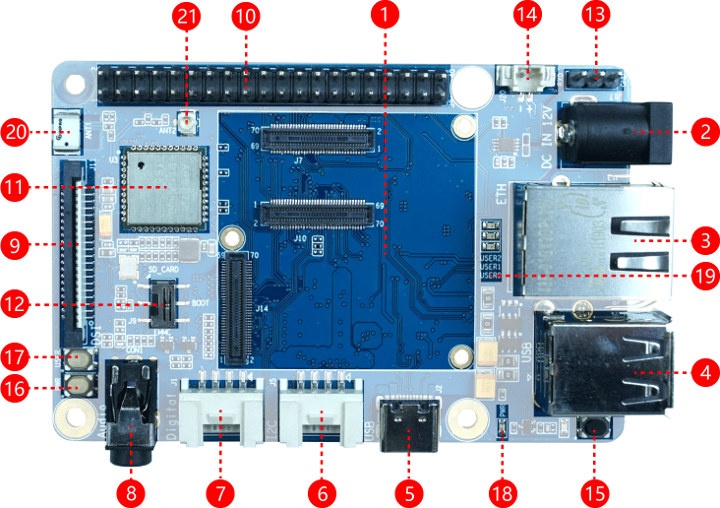
SoM-STM32MP157C SoM

Module specifications:
- MPU (1) – STMicro STM32MP157C dual-core Arm Cortex-A7 processor @ 650 MHz, and Arm Cortex-M4F MCU
- System Memory (2) – 512MB DDR3 RAM
- Storage (4) – 4GB eMMC flash
- Host Connectors – 3x 70-pin board-to-board connectors with HDMI, USB, Gigabit Ethernet, audio GPIOs, etc…
- Misc – Power and USER LEDs
- PMU (3) – STPMIC1A power management IC
- Dimensions – 38mm x 38mm
The module is said to targets consumer and industrial applications, white goods, medical equipment, and wearable devices.
NPi-STM32MP157C baseboard

Key features and specifications:
- SoM Support – Compatible with SOM-STM32MP157C described above
- Storage – MicroSD card slot
- Display I/F – 1x MIPI DSI interface
- Audio – 3.5mm audio jack, WM8960 audio codec
- Camera I/F – 1x DVP camera interface
- Networking & Wireless Connectivity
- 1x Gigabit Ethernet (RJ45)
- 2.4 GHz 802.11b/g/n WiFi 4 and Bluetooth 4.1 (Ampak AP6236)
- USB – 2x USB 2.0 host ports, 1x USB 2.0 Type-C port
- Expansion
- 40-pin Raspberry Pi GPIO connector
- 2x Grove connectors (GPIO & I2C)
- Debugging – 3-pin debug UART header
- Misc
- Reset LED, 3x user LEDs, power LED
- Reset and user buttons, dial code key
- Boot selection switch (eMMC or SD card) (12)
- RTC battery header (14)
- Power Supply – 12V to 24V/2A via DC jack (12V recommended) or 5V/3A via USB Type-C port
- Temperature Range – 0 to 75°C

Software, Documentation, and Pricing
The company provides code samples with an Arduino sketch running on their Seeeduino V4 board connected to a CAN Bus shield, and a Python script running Qt on the STM32MP1 SBC, as well as PDF schematics for both the baseboard and SoM, and documentation such as the pinout diagrams for all connectors and headers on Github. Note documentation is available both in Chinese and English, just click on the “EN” files to get the English versions. The board is supposed to run Linux, but I could not find OS images nor source code at the time of writing.
Seeed Studio is not selling ODYSSEY-STM32MP157C SBC directly on their own online store just yet, but we can find the board on Digikey and Mouser for around $27 for the SoM, and $58.5 for the SoM and baseboard. As I understand it, both companies refer to NPi-STM32MP157C as the SOM + baseboard kit instead of just the baseboard, and there’s no mention of ODYSSEY-STM32MP157C.

Jean-Luc started CNX Software in 2010 as a part-time endeavor, before quitting his job as a software engineering manager, and starting to write daily news, and reviews full time later in 2011.
Support CNX Software! Donate via cryptocurrencies, become a Patron on Patreon, or purchase goods on Amazon or Aliexpress




